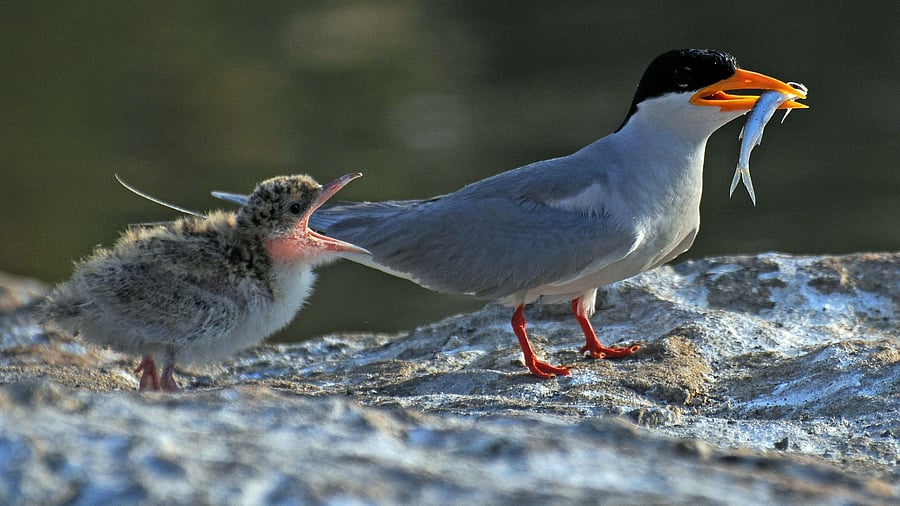
A river tern with a prey Representative image.
Credit: DH Photo
As winter retreats, small sandy and rocky islets emerge from the receding waters of the Bhadra reservoir in Shivamogga district. These islets welcome thousands of river terns that have chosen this place to nest.
A wader bird, river terns (Sterna aurantia) arrive on two to three key islands in the Bhadra reservoir from December to January and stay from February to June during their breeding seasons. Their courtship displays, nesting rituals and chick-rearing activities fill the islands with life.
“These nesting grounds, with relatively lesser human intervention in Bhadra, are crowded with thousands of eggs. Yet, the parent birds recognise and care for their eggs,” says Kartik N J, a research scholar at Kuvempu University.
Karthik and his guide Vijaya Kumara have been studying the river terns of Bhadra for the last few years. In the first-of-its-kind study in Karnataka, Karthik and his team are working to understand and preserve the vulnerable species and their natural habitats.
“Birds are bio-indicators and help understand climate change. However, not much is known about the terns of Bhadra and this makes the study significant,” says Karthik.
Studying the terns comes with its own set of challenges as the place falls under the Bhadra Tiger Reserve. “There are close to no studies conducted earlier, every aspect of the river terns needs documentation,” says Vijaya Kumara, chairman of the Department of Wildlife and Management at Kuvempu University.
According to their study, the two islands of Bhadra, spread over 17.6 acres, are home to river terns, white-winged terns, whiskered terns, gull-billed terns and little terns. In 2023, the island saw nearly 10,000 terns make their way for the breeding season. About 3,600 nests were counted.
“The habitat here provides isolation, suitable nesting surfaces safe from predators and has ample fish supply, crucial for feeding both adults and chicks during breeding,” adds Vijaya Kumara.
On hatching, chicks from different nests come together in a group, forming informal crèches, with adults taking turns to ensure a supply of feed and safety, says Karthik. The population of terns, however, has been on the decline in most of the country due to human disturbances, climate change and other natural factors.
Education
To create awareness about the need to conserve birds, Karthik has been educating local fisherpeople.
26-year-old Karthik, who is also the Karnataka state co-ordinator for the India Bird Conservation Network and resource person for the Karnataka Eco Tourism Board, trains local youths to become certified nature guides and conducts camps for school children.
Through over 150 camps, he has reached communities across Karnataka to build a climate-conscious community that values biodiversity. His human-bird conflict project supports farmers by helping them distinguish between harmful and beneficial bird species, promoting a balanced approach to agriculture and conservation.
In November 2024, he participated in the United Nations Climate Change Conference (COP29) as a youth climate leader with UNICEF India and Yuwaah, held at Baku in Azerbaijan where he focussed on the importance of nature-based solutions for climate change.
“Trained naturalists, like Karthik, have been creating awareness on forest fires, hunting, animal behaviours, habitat conservation and other aspects to promote controlled tourism,” says Rahul Aradhya, chief naturalist working with the Karnataka Tourism Development Board.
According to Vijaya Kumara, some local homestays and resorts do take tourists to watch the river terns during the breeding season and if done in controlled and sensitive ways, this can help people understand the biodiversity of the land and create interest in birds.
Despite the studies, one question remains unanswered — where do the terns that come to Bhadra originate? To find an answer, Karthik and his team will soon tag the birds to understand their migratory pattern.
“Tagging will help unveil many fascinating details about these birds and also the habitat they choose. This will help in understanding the population and keep an eye on ecological and anthropological changes including disturbance rate in a particular area,” says Mumbai-based Sathiyselvam, deputy director and head of Wetlands & Flyways Programme.
The Bhadra Tiger Reserve, led by its field director Yashpal Kshirsagar and the local staff of Lakkavalli Wildlife Range, are also supporting the research in order to help in the conservation of the birds.